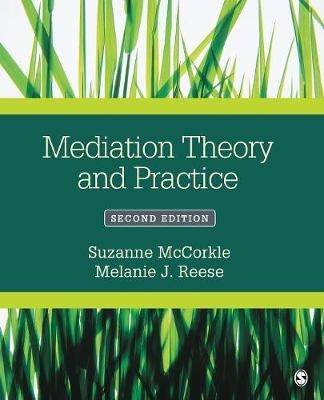
Mediation Theory and Practice
SAGE Publications Inc (Verlag)
978-1-4833-4685-4 (ISBN)
- Titel erscheint in neuer Auflage
- Artikel merken
Mediation Theory and Practice, Second Edition introduces students to the process of mediation to help others manage conflicts and resolve disputes. This text provides an introduction to the research and theory that underlie mediation, as well as the foundational skills that a mediator must possess in any context, including issue identification, setting the agenda for negotiation, problem solving, settlement, and closure.
The Second Edition has been updated with new examples, the latest developments in the field, and new activities and case studies throughout each chapter to assist the student in developing their mediation competency.
Suzanne McCorkle (Ph.D., University of Colorado at Boulder, rhetoric & argumentation; M.A. & B.S., Ball State University, rhetoric & argumentation; speech & secondary education) is director of the Dispute Resolution Program at Boise State University where she is a professor in the Public Policy and Administration department. McCorkle is the co-author of Mediation Theory and Practice, Second Edition (SAGE), Personal Conflict Management (Allyn & Bacon), and People Skills for Public Managers (M.E. Sharpe). Melanie J. Reese is a Dispute Resolution Coordinator for the Idaho State Department of Education. She is a former Faculty Ombudsman for the communication faculty at the College of Western Idaho and Associate Professor of Communication at Boise State University. She is the co-author of Mediation Theory and Practice, Second Edition (SAGE) and Personal Conflict Management (Allyn & Bacon).
Chapter 1: Introduction to Mediation
Why Mediation?
How Do People Find Their Way to Mediation?
Power, Rights, and Interests
The Dispute Resolution Continuum
A Disclaimer about Mediation Training
Summary
Portfolio Assignment 1.1: Starting Your Mediator Portfolio
Chapter 2: The Basic Components of Mediation
Philosophical Assumptions
Functional Models
Integrating Philosophies
Variables That Make a Difference in Mediation Models
Phases in the Balanced Mediation Model
Does Culture Matter In Mediation?
Summary
Chapter 3: Essential Skills for Mediators
An Overview of Mediator Skills
Trusting and Controlling the Process
Listening: A Bedrock Skill for Mediators
Reframing Messages
Listening to Nonverbal Communication
Clarifying and Asking Questions
Genuinely Curious Questions
Honoring Silence
Listening Interculturally
Ethical Issues and Listening
Summary
Mediator Portfolio Assignment 3.1: The Emotional Paraphrase
Mediator Portfolio Assignment 3.2: The Open-Ended Question
Chapter 4: Pre-Mediation Activities
Contacting Disputants
Goals to Accomplish During Intake
Setting the Stage
Ethical Issues for Pre-Mediation Caseworkers
Summary
Portfolio Assignment 4.1: The Referral Sourcebook
Portfolio Assignment 4.2: Intake and Agreement to Mediate Forms
Chapter 5: Ethical Considerations and Tactical Preparations
Mediator Roles
Ethical Considerations for Mediators
Disputant Roles
Analyzing Stakeholders
The Mediation Plan
Common Causes of Conflict
Conflict Causes and Mediator Moves
Cultural Awareness
Summary
Portfolio Assignment 5.1: Ethical Codes of Conduct
Portfolio Assignment 5.2: Mediator Supplies
Chapter 6: The Mediator’s Opening Statement
Opening Statement Functions
Opening Statement Styles
Opening Statement Dynamics
Key Components of the Opening Statement
Building Credibility and Rapport
The Relationship between Opening Statements and Mediator Control
Notetaking for Mediators
Summary
Portfolio Assignment 6.1: Creating Your Personal Opening Statement
Portfolio Assignment 6.2: Creating Your Personal Notetaking Form
Chapter 7: Storytelling and Issue Identification
Theories of Storytelling
Functions of Storytelling
Mediator Strategies in Storytelling
Conflict Causes and Mediator Moves
Overcoming Common Pitfalls in Storytelling
Summary
Portfolio Assignment 7.1: The Vision Quest
Portfolio Assignment 7.2: Reframes
Chapter 8: Setting the Agenda for Negotiation
The Mediator’s Notes are the Building Blocks of the Agenda
When to Shift to the Agenda Step
Components of the Agenda
Sequencing the Agenda List
The Language of the Agenda
Summary
Portfolio Assignment 8.1: Methods of Ordering the Agenda
Portfolio Assignment 8.2: Transitioning to the Agenda
Chapter 9: Problem Solving and Negotiation
The Two Worlds of Negotiation
Directiveness vs. Intrusiveness
Mediator Techniques to Foster Disputant Problem Solving
Using the Caucus to Respond to Common Problems
Breaking Deadlocks
Face-Saving
Ending the Negotiation Phase
Mediator Ethics and the Negotiation Phase
Summary
Mediator Portfolio 9.1: Questions to Start Negotiation
Mediator Portfolio 9.2: Going into Caucus
Chapter 10: Settlement and Closure
Why Write Agreements?
Is the Agreement Legally Binding or Legally Nonbinding?
A Format for Writing Mediation Agreements
Choosing the Phrasing of the Agreement
Creating Durable Agreements
Final Reading and Signing
Closing a Nonagreement Mediation
Debriefing the Session
Summary
Portfolio Assignment 10.1: The Memorandum of Agreement Form
Portfolio Assignment 10.2: The Referral Sourcebook
Chapter 11: The World of the Mediator
Variations on Basic Mediation
Mediation as a Profession
Mediation Skills in Everyday Life
The Promise of Mediation
Summary
| Verlagsort | Thousand Oaks |
|---|---|
| Sprache | englisch |
| Maße | 187 x 231 mm |
| Gewicht | 450 g |
| Themenwelt | Sozialwissenschaften ► Politik / Verwaltung ► Europäische / Internationale Politik |
| Sozialwissenschaften ► Soziologie | |
| ISBN-10 | 1-4833-4685-4 / 1483346854 |
| ISBN-13 | 978-1-4833-4685-4 / 9781483346854 |
| Zustand | Neuware |
| Haben Sie eine Frage zum Produkt? |
aus dem Bereich



